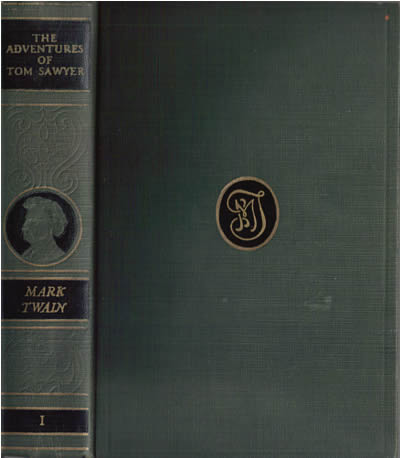 Authorized Edition was "almost a gift" |
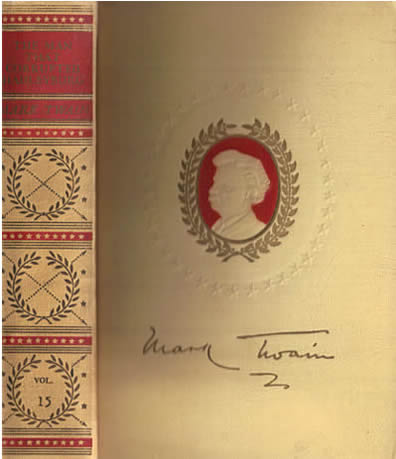 American Artists Edition was considered the "de luxe" profit maker |
History and Description of the Authorized Edition and American Artists Edition
The Harper and Brothers "little green" Authorized Edition and the American Artists Edition are bibliographic puzzles for book buyers and collectors. Some Harper printing codes indicate that printing plates used for the editions were plates that had been used in earlier more expensive sets. Other printing codes as late as 1935 are found in some volumes. No evidence has been found that the editions were ever marketed directly by Harper and Brothers and no evidence has been found to indicate the sets were marketed prior to 1937. Following the history of the editions through available advertising and the memoirs of the people involved indicates the primary purpose of the sets was an enticement to increase newspaper circulation. This was accomplished by luring readers to buy daily newspapers featuring clippable coupons that could be redeemed, along with a few cents, for books until a complete set was obtained. Added to this marketing program was a "bait and switch" technique -- lower priced editions were advertised, but buyers were enticed to step up to a "de luxe" edition. Sales of the de luxe edition would provide profits to cover the marketing costs of the sales program.
The volumes in both the Authorized Edition and American Artists edition measure 4 3/4" x 7" making them the smallest of previous uniform editions. The sets eventually came to encompass 26 volumes. How the volumes came to be arranged and who was in charge of selecting the illustrations they contain are details that have yet to be uncovered. However, the methods by which they were sold were unique at the time.
How the New York Post Started the Mark Twain Continuity Program
The marketing program by which the Authorized Edition and the American Artists edition were sold through daily newspapers is known as a "continuity" program that first originated in England. One of the most capable and talented promoters of this method of books sales during the 1930s was a young Englishman named John Alun Stevenson (b. 1916 - d. 2002). Stevenson was the son of William Henry Stevenson, a British coal miner turned journalist, a former press officer to British Prime Minister Ramsay MacDonald, and editor of the London Daily Herald. As a teenager, John Stevenson worked at Odhams Press, parent company of the Daily Herald. He learned how to write mail order advertising and how to increase newspaper circulation with promotional offers for selling books at a few pennies over cost. Using circulation come-ons and gimmicks, the London Daily Herald had increased their circulation from 350,000 to over a million in one year. Stevenson explained the technique, "Only if you would read the paper each day and clipped a daily coupon could you qualify for the bargain. The object was to increase circulation of the Daily Herald. ... When we first ran ads offering books pennies above cost, we had a runaway success. We did it again and again. The ads sold tons of books and circulation soared" (Hoge, p. 155). The London Daily Herald would eventually claim the largest circulation of any newspaper in the world, with daily sales of over 2 million copies.
From England, young John Stevenson traveled to Melbourne, Australia and set up a book promotion program for the Melbourne Herald, owned by Sir Keith Murdoch, father of Rupert Murdoch. From Australia, Stevenson, who was only nineteen years old at the time, traveled to the United States.
On December 15, 1933, at the urging of President Franklin D. Roosevelt, publisher J. David Stern (b. 1886 - d. 1971) purchased the failing New York Post newspaper which he would hold for six years. Stern later described the moment, "Then began the hardest six years of my life" (Stern, p. 220). At the time of Stern's purchase, the Post which had a circulation of about 60,000 was losing about $25,000 weekly. Stern was publisher of the Philadelphia Record as well as several smaller newspapers. By the fall of 1934 Stern and his business manager, Jake Omansky, who had been the circulation expert for The Stars & Stripes newspaper during World War I had managed to increase the Post's circulation to 100,000. According to Stern, William H. Stevenson of the London Daily Herald recommend his young son John Stevenson to help the Post establish a successful book distribution operation that was a key factor in turning around the Post's circulation numbers. Stern recalled that the first Post promotion was for a two-volume set of Webster's Unabridged Dictionary set from 1908 plates that Omansky found in a junk yard. Stevenson himself later recalled, "The first offer I set up for them was for the Complete Works of Charles Dickens -- four volumes a month for 93¢. It was a hit" (Hoge, p. 155). According to Stern, Stevenson and Omansky went on "to distribute millions of books, complete sets of Shakespeare, Mark Twain, Robert Louis Stevenson, Balzac, Victor Hugo, Dickens, Dumas, Joseph Conrad, and others" (Stern, p. 124).
Advertising from the historical files of the New York Post indicates that the Dickens promotion began in 1936. The Dickens promotion was followed almost a year later by the Mark Twain promotion.
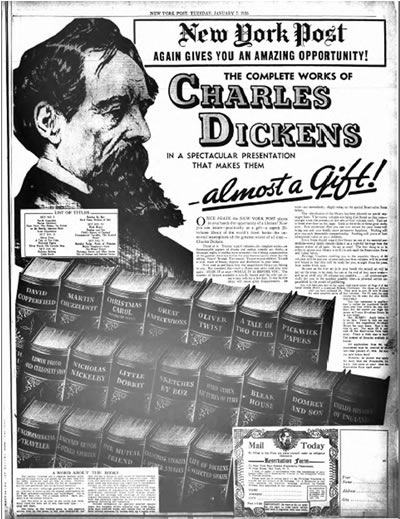 Dickens promotion ad from New York Post, January 7, 1936 |
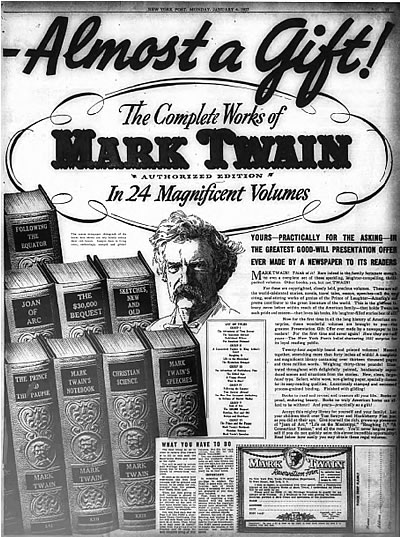 Mark Twain ad for Authorized Edition from New York Post, January 4, 1937 |
The initial newspaper ads for the Authorized Edition being distributed by the New York Post listed no prices. Only after readers signed up for the promotion, did they receive further details. The advertising copy was likely written by Stevenson whose goal was to build desire for the sets. Readers were urged to reserve their set at no charge and then to receive a brochure with additional information. The Mark Twain promotion by the New York Post ran through May 1938. The Post published their expiration notice on April 29, 1938.
 |
The Post's expiration notice indicates readers were charged 93¢ for each 4 volumes of the 24-volume Uniform Edition of Mark Twain's works (about 23¢ per volume) plus 24 newspaper coupons or certificates. The American Artists volumes were sold at 4 for $1.66 (about 41¢ per volume) until a complete set of 24 volumes was obtained. According to the advertising, Harper and Brothers had manufactured 100,000 sets of the books. However no distinction was made between the Uniform Edition and American Artists Edition. The entire promotion was aimed at getting readers to continue buying the daily newspaper in order to obtain coupons for the books at reduced prices. However, the promotions enabled American readers to obtain uniform editions of Mark Twain's works at prices that had never been lower. A 24-volume set of the Authorized Edition cost the reader $5.58 while the American Artist Edition totaled $9.96 if they also purchased enough newspapers via the New York Post's continuation program. |
Stevenson Expands the Book Promotions
While the New York Post may have been the first newspaper in the country to offer Mark Twain uniform editions via a newspaper continuity program, other newspapers also got involved in the practice. Ads for the Harper and Brothers Authorized Edition and American Artists Editions have been found in other newspapers including the Newark Advocate and American Tribune, Cleveland Plain Dealer, Rockford (Illinois) Morning Star, and the Omaha World Herald. According to Stevenson, he had a string of offers to set up the program with other newspapers throughout the country and he went into the business for himself.
I did what I had successfully done -- but for any newspaper anywhere and using books and records. I sold directly to newspapers and would run the ads under their name as a joint venture with the paper taking the promotion risk. Or I would buy the ad but still run under their name and I would take the risk. We'd try for a special rate because we were helping the paper increase circulation. Essentially, the entire hope of profit was to get subscribers to take a deluxe edition which cost a few cents more to produce and for which we charged 39¢ to 50¢ more per book. Enough did so for us to do very well. (Quoted in Hoge, p. 156).
As Stevenson branched out across the country with the book promotions, the cost of acquiring the Mark Twain editions rose. An ad from the Newark Advocate and American Tribune indicates the prices had increased. A volume of the Authorized Edition would cost a reader about 33¢ and an American Artist volume about 60¢.
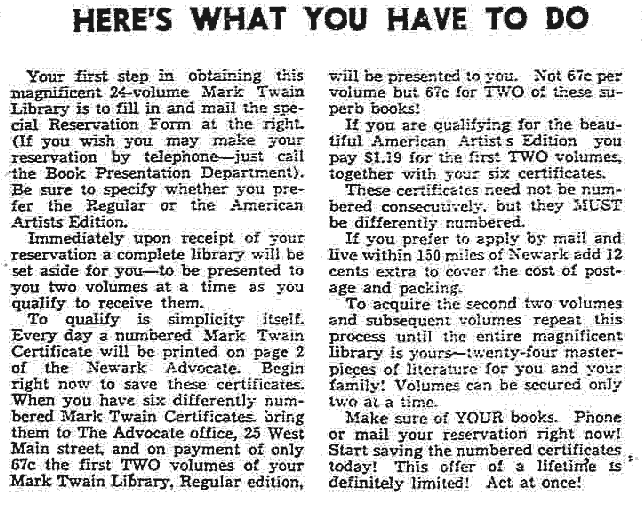
Ad from Newark
Advocate and American Tribune, 13 September 1937
The Summer-Fall issue of the Mark Twain Journal featured a large advertisement with Cyril Clemens's endorsement along with a long list of other newspapers that had signed on with Stevenson's promotion.
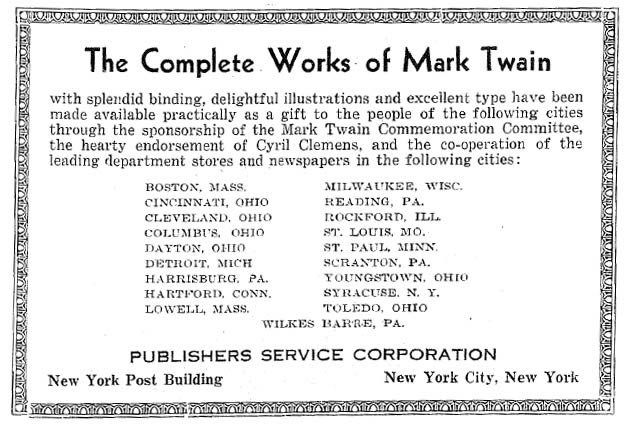
Ad from Mark
Twain Journal, Summer-Fall 1939 issue
Readers who responded to ads for more information received by mail a promotional poster measuring 17" x 22" featuring a letter, likely written by John Stevenson, a colorized portrait of Mark Twain by newspaper artist George A. Amy, and a full color layout of the American Artists Edition features. The following undated letter text is from a promotion run under the auspices of the Chicago Tribune.
_____
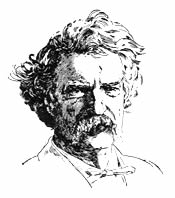 |
 |
|
Dear Reader: Congratulations on your prompt acceptance of our great Mark Twain Presentation Offer. We were pleased to receive your application and have reserved in your name a magnificent, twenty-four volume library of the "Complete Works of Mark Twain." As previously explained, the distribution of these books has been planned along special lines -- they come to you in groups of two volumes each -- two books every two weeks. Your first two volumes are now on the presses and will be ready for you so soon as you have qualified. We have made it easy as can be for you to qualify -- just follow the simple rules printed in the separate folder enclosed with this brochure. And in the folder you will find also your twelve Privilege Vouchers. These you should keep as carefully as you would money, since you will need them in order to obtain your library. Your first two volumes -- "The Adventures of Tom Sawyer" and "The Innocents Abroad" -- will be given to you the moment you have collected twelve differently numbered Mark Twain Certificates from the Chicago Tribune. Read the titles of your wonderful Mark Train library again. Think of the countless hours of pleasure, the priceless enrichment of mind these immortal writings will bring to you, your family, your children. The magic of this supreme author is irresistible -- you will read his fascinating works again and again -- spend endless enchanted hours in the company of Mark Twain, America's beloved Prince of Laughter. After your first two books come the next two -- and the next until your library of twenty-four majestic volumes is complete. Imagine the thrill of watching it grow! Now -- first we want to point out to you the beautifully reproduced portrait of Mark Twain on the back of this brochure, specially painted for you by a well-known artist, George Amy, and then expensively engraved so that you might have it framed. What a pleasant picture this will make when hung near your Twain Library! Next -- we have some GREAT NEWS for you! Here is a library you will treasure not merely today or just tomorrow, but for all time. You will own volumes that will distinguish any room and constantly serve as a reflection of your own discriminating taste. That is why we are pleased to announce another special privilege -- but only for readers who will act IMMEDIATELY. For those booklovers who can be satisfied with nothing less than the finest materials and workmanship obtainable, we have prepared a special and limited American Artists Edition -- of unsurpassed richness, encompassing many added, captivating features. This superb de luxe edition is a set of volumes any connoisseur would be proud to call his own. Turn to the inside pages and read about this regal edition now -- for today you may have your choice of receiving either the Regular or the American Artists Edition. BEFORE YOU DO ANYTHING ELSE, DECIDE WHICH EDITION YOU DESIRE. IF YOU PREFER THE AMERICAN ARTISTS EDITION, FILL IN THE GREEN PREFERENCE CARD MARKED "FOR IMMEDIATE ATTENTION" AND MAIL IT BACK TO US AT ONCE! OTHERWISE WE RESERVE THE RIGHT TO HOLD THE REGULAR EDITION FOR YOU. Cordially yours, |
|
 |
|
| REMEMBER! THE AMERICAN ARTISTS EDITION - available for a nominal extra amount - IS AN ADDITIONAL SPECIAL CONCESSION. AND THOUGH READERS MAY TAKE THEIR CHOICE, INSTANT ACTION IS IMPERATIVE. YOU MUST DECIDE TODAY! | |
_____
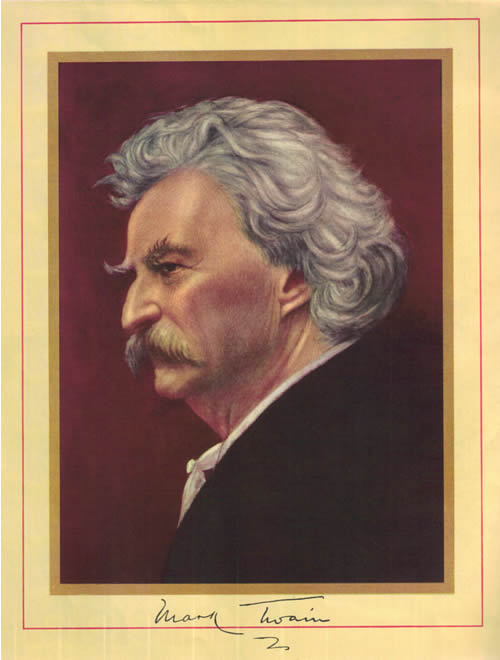
A color portrait
by George A. Amy based on a 1901 photograph of Mark Twain was included on
the poster advertising the American Artists Edition.
_____
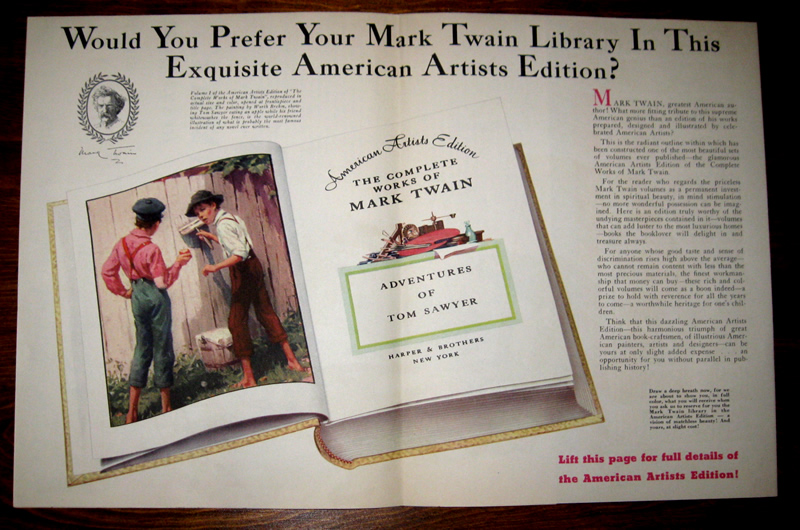
Buyers were
encouraged to step up to the American Artists edition.
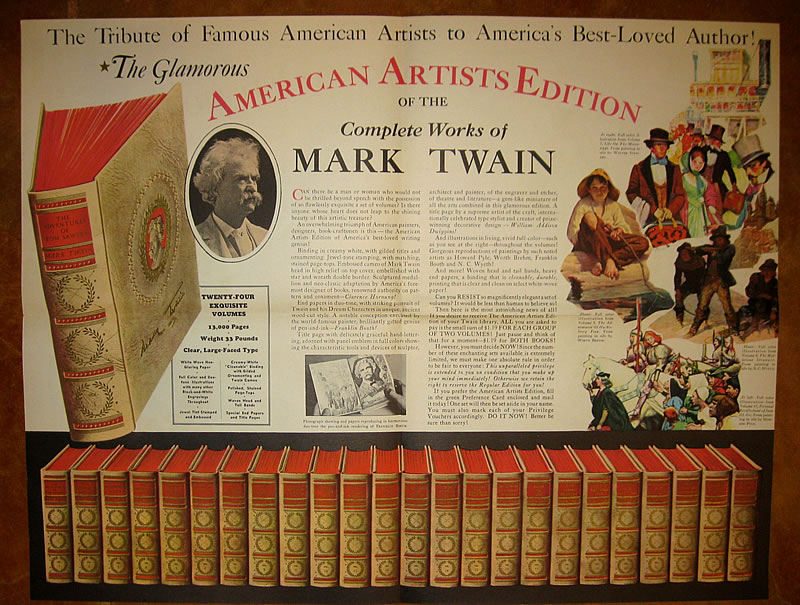
17" x 22"
poster mailed to prospective buyers urging them to select the de luxe American
Artists edition
The Authorized Edition and American Artists Edition sales promotions continued until at least 1939. John Stevenson became a promotion manager for Doubleday publishers and also began issuing his own line of books under the imprint of Book Presentations. In 1943 Stevenson purchased Greystone Press. The United States was in the middle of World War II and Stevenson need Greystone's wartime allotment of paper to continue his own Book Presentations imprint. In 1945 Stevenson served with the United States Strategic Bombing Survey in Germany. After the war Stevenson returned to the United States and focused his business on Greystone Press and direct mail marketing. Stevenson died in New York in February 2002.
The Volumes and the Artists
While no advertising credited the designers involved in the Authorized Edition of Mark Twain's works, those involved in the American Artists edition were highly praised and publicized. Well-known graphic designer Clarence Pearson Hornung (b. 1899 - d. 1997) was credited with designing the cover of the American Artists Edition. In all probability, Hornung also designed the cover for the lesser priced Authorized Edition. End papers for the American Artists Edition were designed by Franklin Booth (b. 1874 - d. 1948). Booth had previously illustrated the 1917 holiday edition of The Prince and the Pauper for Harper and Brothers. Booth's signature appears in the upper left page of the endpapers.
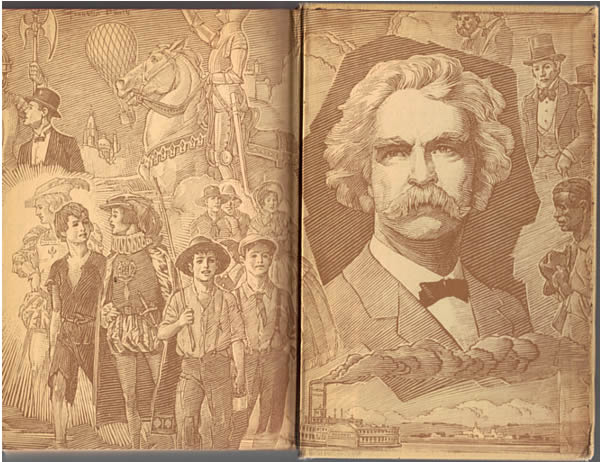
End papers for
the American Artists edition by Franklin Booth features a portrait of Mark
Twain along with his characters.
The title page for the American Artists de luxe edition was described in the sales literature as:
Title page with delicately graceful hand-lettering, adorned with panel emblem in full colors showing the characteristic tools and devices of sculptor, architect and painter, of the engraver and etcher, of theatre and literature -- a gem-like miniature of all the arts combined in this glamorous edition. A title page by a supreme artist of the craft, internationally celebrated type stylist and creator of prize-winning declarative design -- William Adidson Dwiggins!
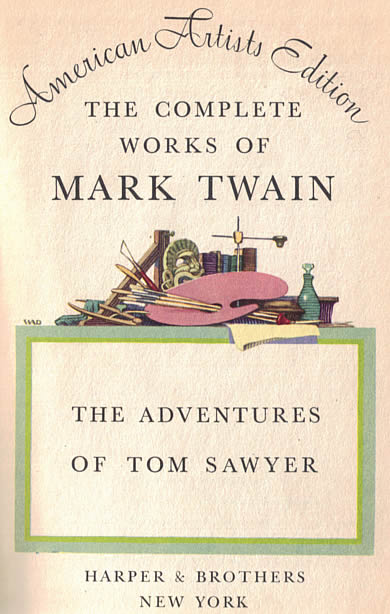
Both the Authorized Edition and American Artists Edition feature the same
contents and the same volume numbering. The American Artists Edition features
papers with top edges that have maroon or deep red staining to match the title
panels on the spine and the cameo of Mark Twain against a deep red background
on creamy white binding. However, the major differences between the editions,
other than the bindings, are the colored frontispieces and additional illustrations
that are in the American Artists editions. Most illustrations were from Harper's
archives of previous editions. Some illustrations that had originally been
published in black and white are featured in color in the American Artists
edition. Although no credit is given for which artist or artists were responsible
for adding color to the old illustrations, George A. Amy and William Addison
Dwiggins are possible candidates due to their known involvement in the production
of the editions. In order to fully understand the differences between the
two editions, side by side comparisons of the illustrations are given in the
following tables. Neither edition features a printed illustration list within
the volumes.
_____
Comparing the Volumes in the Two Editions
Volume 1 - The Adventures of Tom Sawyer
Both volumes have Harper printing code D-F (April 1931)
|
Authorized Edition
|
American Artists Edition All illustrations are full page illustrations by Worth Brehm which first appeared in a Harper and Brothers 1910 holiday edition of The Adventures of Tom Sawyer. With the exception of the colored frontispiece, all are black and white illustrations.
|
_____
Volume 2 - The Innocents Abroad
Both volumes feature Harper printing code L-K (November 1935). The Innocents Abroad was divided into two separate volumes for the uniform edition first issued by American Publishing Company in 1899 and in subsequent uniform editions thereafter. Both Harper's Authorized Edition and American Artists Edition retain the two-volume format, binding both into one volume. Thus the book is divided into separate sections with separate title pages. American Artists Edition features a unique title page for Volume 1 of The Innocents Abroad. However, in what is an anomaly in the American Artists Edition, Volume 2 of The Innocents Abroad features a title page identifying it as the Authorized Edition. The publishing or binding error emphasizes the fact that the real difference in the editions is solely in the illustrations. Both volumes feature illustrations that were drawn by Peter Newell for American Publishing Company's 1899 uniform edition.
|
Authorized Edition
|
American Artists Edition
|
_____
Volume 3 - Pudd'nhead Wilson
Both volumes feature Harper printing code B-K (February 1935). Included in the editions, but not the title, is "Those Extraordinary Twins." Illustrations in both the Authorized Edition and American Artists edition are by Edward Windsor Kemble from American Publishing Company's 1899 uniform edition. The Authorized Edition features an error in the captioning of the frontispiece. The title for that frontispiece is given as "He is a Pudd'nhead." The original illustration with that title features a group of townspeople discussing the title character. However, the frontispiece is actually an illustration that was featured in previous editions and titled "Tom Found the Old Deformed Negro Bell-Ringer Imitating His Fancy Eastern Graces." The same illustration with the correct title appears in the American Artists Edition.
|
Authorized Edition
|
American Artists Edition
|
_____
Volume 4 - The American Claimant
The Authorized Edition and American Artist Edition of The American Claimant feature Harper printing code I-D (September 1929). This is the same printing code as the Stormfield Edition of The American Claimant and indicates that, aside from introductory material, the same set of printing plates was likely used for all three editions. Illustrations are by James Allen St. John from the American Publishing Company's 1899 uniform edition of The American Claimant.
|
Authorized Edition
|
American Artists Edition
|
_____
Volume 5 - A Connecticut Yankee in King Arthur's Court
Both Authorized Edition and American Artists Edition feature Harper printing code I-D (September 1929) -- the same printing code as the Stormfield Edition and indicates that the same set of printing plates was likely used for all three editions. The Authorized Edition features a Dan Beard illustration from American Publishing Company's 1899 uniform edition. The American Artists Edition features illustrations by Henry C. Pitz from the Harper 1925 holiday edition of A Connecticut Yankee in King Arthur's Court.
|
Authorized Edition
|
American Artists Edition
|
_____
Volume 6 - Roughing It
Both Authorized Edition and American Artists Edition feature Harper printing code I-D (September 1929) -- the same printing code as the Stormfield Edition and indicates that the same set of printing plates was likely used for all three editions. Roughing It was divided into two separate volumes for the uniform edition first issued by American Publishing Company in 1899 and in subsequent uniform editions thereafter. Both Harper's Authorized Edition and American Artists Edition retain the two-volume format, binding both into one volume. Both the Authorized Edition and American Artists Edition feature illustrations by Benjamin West Clinedinst which first appeared in American Publishing Company's 1899 uniform edition Roughing It. In addition, the American Artists Edition features artwork by Edmund Franklin Ward that had been previously used in the Gabriel Wells Definitive Edition of Roughing It as well as the Stormfield Edition.
|
Authorized Edition
|
American Artists Edition
|
_____
Volume 7 - Life on the Mississippi
Both Authorized Edition and American Artists Edition feature Harper printing code I-D (September 1929) -- the same printing code as the Stormfield Edition and indicates that the same set of printing plates was likely used for all three editions. An illustration by Edmund Henry Garrett first used in the 1899 American Publishing Company's uniform edition of Life on the Mississippi appears in the Authorized Edition. The American Artists Edition features illustrations from Harper's 1927 holiday edition by Frank Schoonover and Walter Stewart. Two illustrations by Stewart have not been found in the previous holiday editions and their use in the American Artists Edition may represent first appearances for each.
|
Authorized Edition
|
American Artists Edition
|
_____
Volume 8 - The Mysterious Stranger
Both Authorized Edition and American Artists Edition feature Harper printing code I-D (September 1929) -- the same printing code as the Stormfield Edition and indicates that the same set of printing plates was likely used for all three editions. The seven stories in this collection are the same as those found in the first edition of the book issued by Harper and Brothers in 1922 in their Uniform Library edition. The title story, "The Mysterious Stranger," first appeared over a seven month period from May to November 1916 in Harper's Magazine. Each month's installment featured a full-page color illustration by Newell Convers Wyeth. The installments and color illustrations were collected and printed as a Harper's holiday edition that year. Both Authorized Edition and American Artists Edition feature Wyeth's illustrations.
|
Authorized Edition
|
American Artists Edition
|
_____
Volume 9 - The Adventures of Huckleberry Finn
Both Authorized Edition and American Artists Edition feature Harper printing code I-D (September 1929) -- the same printing code as the Stormfield Edition and indicates that the same set of printing plates was likely used for all three editions. The Authorized Editions features a black and white frontispiece by Edward Windsor Kemble that first appeared in American Publishing Company's 1899 Uniform Edition of Adventures of Huckleberry Finn. The American Artists Edition features illustrations by Worth Brehm from Harper's 1923 Holiday Edition.
|
Authorized Edition
|
American Artists Edition
|
_____
Volume 10 - The Gilded Age
Both Authorized Edition and American Artists Edition feature Harper printing code I-D (September 1929) -- the same printing code as the Stormfield Edition and indicates that the same set of printing plates was likely used for all three editions. The Gilded Age was divided into two separate volumes for the uniform edition first issued by American Publishing Company in 1899 and in subsequent uniform editions thereafter. Both Harper's Authorized Edition and American Artists Edition retain the two-volume format, binding both into one volume and renumbering the pages of each section. Both editions feature illustrations drawn by William Thomas Smedley for American Publishing Company's 1899 edition of The Gilded Age. However, the American Artists Edition features an anomaly in that illustrations appropriate to the second part of the volume are mistakenly bound into the first part. Binders probably followed page numbers for placing the illustrations without regard as to whether the page numbers were for the first or second part of the volume.
|
Authorized Edition
|
American Artists Edition
|
_____
Volume 11 - A Tramp Abroad
Both Authorized Edition and American Artists Edition feature Harper printing code I-D (September 1929) -- the same printing code as the Stormfield Edition and indicates that the same set of printing plates was likely used for all three editions. A Tramp Abroad was divided into two separate volumes for the uniform edition first issued by American Publishing Company in 1899 and in subsequent uniform editions thereafter. Both Harper's Authorized Edition and American Artists Edition retain the two-volume format, binding both into one volume and renumbering the pages of each section. Both editions feature illustrations by Thure de Thulstrup from American Publishing Company's 1899 uniform edition of A Tramp Abroad as well as some of Mark Twain's own illustrations which are embedded in the text. However, the American Artists Edition features an anomaly in that illustrations appropriate to the second part of the volume are mistakenly bound into the first part. Binders probably followed page numbers for placing the illustrations without regard as to whether the page numbers were for the first or second part of the volume.
|
Authorized Edition
|
American Artists Edition
|
_____
Volume 12 - What is Man?
Both Authorized Edition and American Artists edition feature Harper printing code G-D (July 1929) -- the same printing code as the Stormfield Edition of this title and indicates that the same set of printing plates was likely used for all three editions. The sixteen stories in this collection are the same as those found in the first edition of the book issued by Harper and Brothers in 1917 in their Uniform Library edition. These volumes feature a frontispiece based on a photograph. No other full page illustrations are present. However, some of Mark Twain's own illustrations are embedded with the text.
|
Authorized Edition
|
American Artists Edition
|
_____
Volume 13 - Following the Equator
Both Authorized Edition and American Artists Edition feature Harper printing code I-D (September 1929) -- the same printing code as the Stormfield Edition and indicates that the same set of printing plates was likely used for all three editions. Following the Equator was divided into two separate volumes for the American Publishing Company's uniform edition in 1899 and in subsequent uniform editions thereafter. At that time no new illustrations were commissioned and illustrations from the 1897 first edition were reused. In the years that followed, Harper and Brothers never ordered new illustrations for Following the Equator for subsequent uniform editions. Thus, the Authorized Edition and American Artists Edition feature illustrations from a variety of artists that had appeared in the 1897 first edition of the book. These editions retain the two-volume format, binding both into one volume and renumbering the pages of each section.
|
Authorized Edition
|
American Artists Edition
|
_____
Volume 14 - Tom Sawyer Abroad
Both Authorized Edition and American Artists Edition feature Harper printing code I-D (September 1929) -- the same printing code as the Stormfield Edition and indicates that the same set of printing plates was likely used for all three editions. The contents of the volumes are the same as Harper's 1896 red cloth uniform edition titled Tom Sawyer Abroad / Tom Sawyer Detective and Other Stories, Etc., Etc. with the exception of the final two stories. While the 1896 edition featured twenty stories, both the Authorized Edition and the American Artists Edition feature only eighteen stories. Missing from these editions are "Map of Paris" and "Letter Read at a Dinner."
|
Authorized Edition
|
American Artists Edition
|
_____
Volume 15 - The Man That Corrupted Hadleyburg
Both Authorized Edition and American Artists Edition feature Harper printing code I-D (September 1929) -- the same printing code as the Stormfield Edition and indicates that the same set of printing plates was likely used for all three editions. The contents of these editions are identical to the contents of the book issued by Harper and Brothers under the title The Man That Corrupted Hadleyburg and Other Essays and Stories in previous uniform editions after mid-1917. (For the history of the shifting contents of this volume, see Chapter 25.) Both the Authorized Edition and American Artists Edition feature a frontispiece by Lucius Wolcott Hitchcock from original Harper's Magazine and subsequent book publications.
|
Authorized Edition
|
American Artists Edition
|
_____
Volume 16 - In Defense of Harriet Shelley
Both Authorized Edition and American Artists Edition feature Harper printing code I-D (September 1929) -- the same printing code as the Stormfield Edition and indicates that the same set of printing plates was likely used for all three editions. The contents of this volume are identical to the contents of the book issued by Harper and Brothers under the title Literary Essays in previous uniform editions after mid-1917. (For the history of the shifting contents of this volume, see Chapter 24.) The Stormfield Edition and Mississippi Edition were two of the earliest uniform editions to retitle the volume In Defense of Harriet Shelley. However the copyright pages of the Stormfield Edition, Authorized Edition and American Artists Edition feature Literary Essays as the book's title while the title pages and spines identify the volume as In Defense of Harriet Shelley, the lead essay. Both Authorized Edition and American Artists Edition feature illustrations from previously published uniform editions.
|
Authorized Edition
|
American Artists Edition
|
_____
Volume 17 - Joan of Arc
Personal Recollections of Joan of Arc was divided into two separate volumes for the uniform edition of the work first issued in 1899 by American Publishing Company. Both Authorized Edition and American Artists Edition retain the two volume format bound into one volume and renumbering the pages for each section. Identifying the plates used for these editions is a bibliographic puzzle. The copyright page for the first volume incorrectly identifies it as a printing page for Volume II (the second volume) with code I-D (September 1929). The copyright page for the second volume contains the correct Volume II designation with a printing code of G-A (July 1926). Both the Authorized Edition and American Artists edition feature illustrations from previous uniform editions. The American Artists Edition features three of Howard Pyle's full page colored illustrations from the December 1904 publication of the essay "St. Joan of Arc" in of Harper's Magazine.
|
Authorized Edition
|
American Artists Edition
|
_____
Volume 18 - The $30,000 Bequest
Both Authorized Edition and American Artists Edition feature Harper printing code I-D (September 1929) -- the same printing code as the Stormfield Edition and indicates that the same set of printing plates was likely used for all three editions. The contents of both editions are the same as Harper's uniform edition of The $30,000 Bequest and Other Stories issued after mid-1917. For a complete description of the shifting contents of the book, see Chapter 26. The frontispieces for the Authorized Edition and American Artists Edition were full page illustrations that had previously appeared in the Gabriel Wells Definitive Edition of The $30,000 Bequest and Other Stories.
|
Authorized Edition
|
American Artists Edition
|
_____
Volume 19 - Sketches New and Old
Both Authorized Edition and American Artists Edition feature Harper printing code I-D (September 1929) -- the same printing code as the Stormfield Edition and indicates that the same set of printing plates was likely used for all three editions. Both editions feature the same selection of material as that featured by American Publishing Company's 1899 uniform edition of Sketches, New and Old. Both editions feature illustrations by Frederick Burr Opper that had been commissioned by Frank Bliss for the 1899 uniform edition from American Publishing Company.
|
Authorized Edition
|
American Artists Edition
|
_____
Volume 20 - Europe and Elsewhere
Both Authorized Edition and American Artists Edition feature Harper printing code I-D (September 1929) -- the same printing code as the Stormfield Edition and indicates that the same set of printing plates was likely used for all three editions. Both editions feature the same material as the first edition published by Harper and Brothers in 1923 as well as the Gabriel Wells Definitive Edition of Europe and Elsewhere. Some of the illustrations by Peter Newell which had been used in the Gabriel Wells Definitive Edition are found in both the Authorized Edition and American Artists Edition.
|
Authorized Edition
|
American Artists Edition
|
_____
Volume 21 - The Prince and the Pauper
Both Authorized Edition and American Artists Edition feature Harper printing code I-D (September 1929) -- the same printing code as the Stormfield Edition and indicates that the same set of printing plates was likely used for all three editions. The Authorized Edition features a frontispiece by Frank Thayer Merrill that had originally appeared in the American Publishing Company's 1899 uniform edition of The Prince and the Pauper. The American Artists Edition features a frontispiece by Franklin Booth from Harper's 1917 holiday edition of The Prince and the Pauper.
|
Authorized Edition
|
American Artists Edition
|
_____
Volume 22 - Mark Twain's Notebook
Mark Twain's Notebook (edited and with an introduction by Albert Bigelow Paine) is unique among all the volumes included in the Authorized Edition and American Artists Edition. It was the first time this title had appeared in any uniform edition of Mark Twain's works. The first edition of the book was printed in September 1935, deposited for copyright on October 9, 1935, and issued by Harper and Brothers in a blue cloth binding. The statement "First Edition" appears on the copyright page with printing code I-K (September 1935). According to Harper officials, the statement "First Edition" was a quasi-fiction. During the printing of the trade edition in blue cloth binding, the printing presses were stopped, the "First Edition" statement was removed, and replaced by the statement "Second Edition." The result was that an artificial market was created for volumes containing the "First Edition" statement. Both Authorized Edition and American Artists Edition feature Harper printing code I-K (September 1935) and the statement "First Edition" indicating they were printed from the same set of printing plates as the initial press run. However, the Authorized Edition and American Artists Edition feature frontispieces that were different and unlike the frontispiece utilized in Harper's first trade edition and they do not include one photographic plate of "Notebook Invented by Mark Twain" that had been inserted into the 1935 first edition.
|
Authorized Edition
|
American Artists Edition
|
_____
Volume 23 - Christian Science
Both Authorized Edition and American Artists Edition feature Harper printing code I-D (September 1929) -- the same printing code as the Stormfield Edition and indicates that the same set of printing plates was likely used for all three editions.
|
Authorized Edition
|
American Artists Edition
|
_____
Volume 24 - Mark Twain's Speeches
Both Authorized Edition and American Artists Edition feature Harper printing code I-D (September 1929) -- the same printing code as the Stormfield Edition and indicates that the same set of printing plates was likely used for all three editions. The contents of these editions are the same as Harper's 1923 edition of Mark Twain's Speeches edited by Albert Bigelow Paine. The title had previously been included in both the Gabriel Wells Definitive Edition and the Stormfield uniform editions.
|
Authorized Edition
|
American Artists Edition
|
_____
Unnumbered Volumes - Mark Twain's Autobiography, Volumes I and II
Both the Authorized Edition and American Artists Edition of Mark Twain's Autobiography, Volume I and Volume II feature Harper printing code I-D (September 1929) -- the same printing code as the Stormfield Edition and indicates that the same set of printing plates was likely used for all three editions. Both editions were advertised as sets of 24 volumes. Acquisition of two additional "free" volumes of Mark Twain's Autobiography by Albert Bigelow Paine was also a "continuity" enticement. The 24-volume sets were shipped in installments of four books each and buyers were provided with numbered "Gift Redemption Certificates" with each installment. If a buyer collected and saved all six certificates, they could be redeemed for the two volumes of Mark Twain's Autobiography at no additional charge. Although the two additional volumes push the total number of volumes to 26 for both the Authorized Edition and American Artists Edition, volume numbers 25 and 26 are not printed on the spines. Complete sets of the Authorized Edition and American Artists Edition which include the two extra volumes are rare.
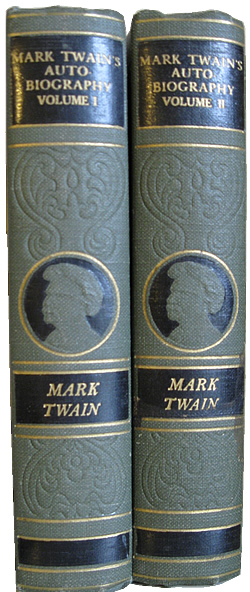 Authorized Edition 2- volume set of Mark Twain's Autobiography |
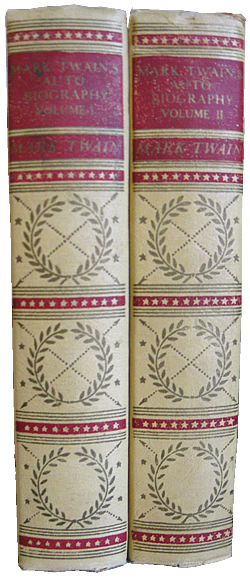 American Artists Edition 2-volume set of Mark Twain's Autobiography |
|
Authorized Edition, Volume I
|
American Artists Edition, Volume I
|
|
Authorized Edition, Volume II
|
American Artists Edition, Volume II
|
_____
Set Decoration in Elmer Gantry
The American Artists volumes, with their distintive size and binding, have been utilized in at least one major motion picture as set decoration. Elmer Gantry, released in 1960, features several scenes where the American Artists edition is clearly visible. Set decorators for this movie were William F. Calvert (b. 1911 - d. 2005) and Frank Tuttle (b. 1905 - d. 1969).
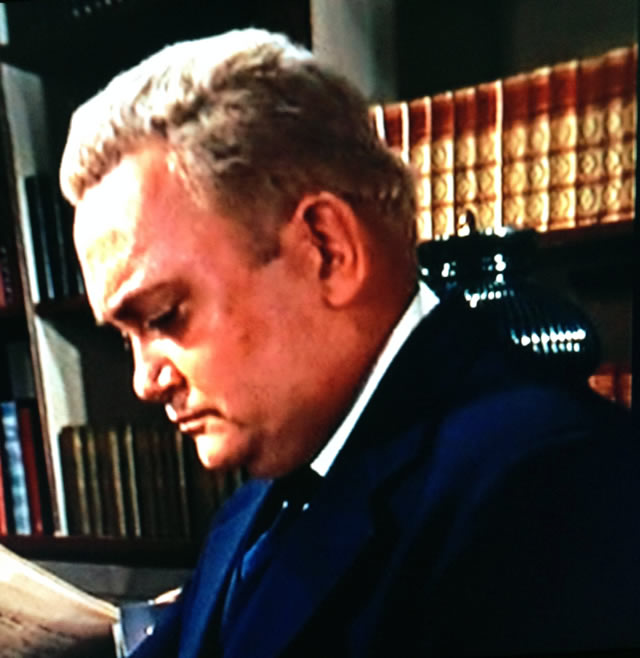
Scene from Elmer
Gantry in which actor Wendell Holmes plays Reverend Ulrich.
Special acknowledgement to Kent Rasmussen for recognizing the American Artists
edition in this movie and providing a still photo.
_____
Summary of Features of the Harper and Brothers Authorized Edition and American Artists Edition
_____
Blanck, Jacob. Bibliography of American Literature, Volume Two. (Yale University Press, 1957).
Bonner, David. "Greystone Cookbook," 16 November 2009. Accessed online 5 January 2012.
Hoge, Cecil C. Hoge, Sr. Mail Order Know-How. (Ten Speed Press, 1982).
"John Alun Stevenson, 86, Theater Patron," The New York Times, 20 February 2002, p. 19.
"Past N. Y. Post Publisher Dies," New Orleans Times-Picayune, 11 October 1971, Section 4, p. 9.
Stern, J. David. Memoirs of a Maverick Publisher. (Simon and Schuster, 1962).